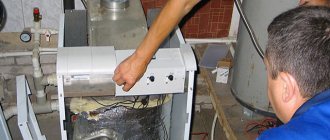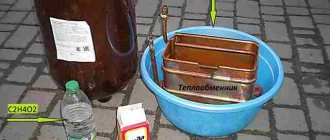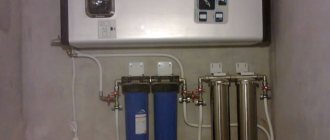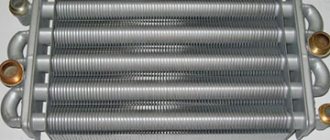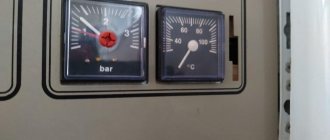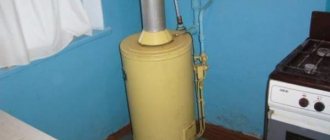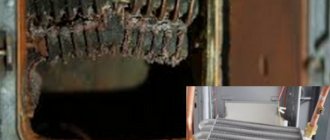When living in your home, the heating system accounts for the largest portion of your expenses. It doesn’t matter whether the owner powers his house from the outside or has his own heating system. One of the available options for heating your home is to equip your boiler room with gas. This is not a water boiler, so there will be slightly fewer problems with scale. But not much, because... and this boiler has a heat exchanger heated by gas. And here, too, there will be the hated limescale, spoiling everything in its path. How to flush a gas boiler? Or is it better to invest in a softener? These issues will become the most pressing for boiler house owners.
Why does scale form?
Flushing the heat exchanger of a gas boiler is necessary when scale appears on this unit. This is usually caused by water with increased lime hardness. The “cocktail” that is supplied to home heating systems is based on a high amount of calcium, magnesium and iron salts. Together with constant heating, these elements begin the process of crystallization on metal surfaces.
The liquid usually enters the coolant after undergoing filtration, but it enters the heat exchangers without purification. This unit is most susceptible to scale formation and requires regular washing.
Scale is the main pest Source prokommunikacii.ru
Why is scale dangerous?
Few people argue that the problem exists, but not everyone knows what its consequences are. The accumulation of deposits on the fins of the heat exchanger has a bad effect on the operation of the heating system:
- Increases fuel consumption . Metal is used in heating system components not only because of its rigidity, but also due to its thermal conductivity properties. Scale does not have such thermal conductivity, and the boiler has to spend more time and fuel on heating. Just 1mm of deposits on the heat exchanger and gas bills will increase by 10%.
- Overheating of the heat exchange element . Heating boilers have a water cooling system that comes from the return line. But when scale forms on the heat exchanger, the system becomes confused, using more force to heat. The problem is fraught not only with increased gas consumption, but also with overheating of the element, which can even damage it.
- Increased load on the heating system . When formations appear on the surface of the nodes, the channels narrow significantly, which impairs the process of water circulation. The workload of the circulation pump system increases, which is why it can also break down.
The harmful effects of scale Source vyborradiatora.ru
Full disassembly service
Do not be afraid to disassemble the water heating installation, the procedure is not that complicated. You will need the most common tools - screwdrivers, pliers, standard wrenches. What to do before starting work:
- Close the taps of the cold water, hot water and gas supply pipelines. Unplug the turbocharged dispenser from the outlet.
- Substituting the container, unscrew the union nuts (American) on the connection of the water pipes. Disconnect the connections from the unit without losing the rubber gaskets.
- For convenience, it is recommended to remove the gas heater from the wall. It is not easy to disassemble and clean a unit that is hung too high or installed in a narrow niche.
- To dismantle the water heater, disconnect the gas line and the chimney pipe. Remove the unit from the hooks.
Lay the hot water column on a horizontal surface and proceed to further work, the order of which is outlined in our instructions.
How to remove the heat exchanger and column burner
We will show the disassembly sequence using the example of a cheap Chinese Novatek water heater. We present step-by-step instructions with photos:
- Remove the control handles mounted on the front panel. Unscrew 2 screws (or 2 plastic clips) and remove the device casing.
- The next step is to remove the smoke collector. To do this, disconnect the wires from the draft sensor and unscrew the screws holding the diffuser box.
- Disconnect the heat exchanger tube from the water unit by disassembling the connection with the union nut. The second pipe must be freed from the lock washer, pressed with 2 screws.
- Disconnect the burner from the gas valve by unscrewing the 2 screws on the flange. Having moved the radiator upward, carefully remove the burner device (pull towards you) and move it to the side.
- Unscrew all screws connecting the heat exchanger to the rear panel of the water heating unit.
- Pull out the radiator completely and remove the burner, disconnecting the wires along with the ignition electrodes.
Note. While removing the heat exchanger, disconnect the wires from the temperature sensor.
Disassembly of geysers from other manufacturers may differ, but not fundamentally. The order of work remains unchanged. Let's list some important points:
- in a chimneyless turbo column, the fan will have to be removed;
- in units of the Italian brands Ariston (Ariston) and some others, the pipes are connected not with nuts, but with self-clamps;
- If the water heater is equipped with an igniter, then before removing the burner it is necessary to disconnect the gas tube connected to the wick.
Important! Be careful not to lose any rubber or other gaskets discovered during disassembly. Before assembling and installing the column, it is advisable to replace these seals with new ones.
Our expert plumber will demonstrate the above process in detail in his video:
Flushing procedure
This operation is very simple compared to disassembly - cleaning the gas water heater begins by immersing the heat exchanger in a container with washing liquid. The procedure is as follows:
- Take a bucket or deep basin, fill it with water and prepare a cleaning solution according to the recipe on the package. The concentration of citric acid is 50-70 grams per 1 liter of liquid.
- Immerse the heat exchanger in the container with the radiator down and the pipes up.
- Using a watering can, fill the coil with detergent. Rinse it periodically by adding new solution.
- Flush the heat exchanger until clean liquid comes out of the tubes without scale flakes. Then run tap water through the coil to remove any remaining product or impurities.
Advice. Using citric acid, heat the solution to a temperature of 50-60 °C. The reaction will be more intense and end faster.
The removed burner can be cleaned from the outside and purged or washed with a solution of citric acid (no more than 50 grams per liter of water). Finally, rinse the element with running water, blow with compressed air and dry thoroughly. Do not ignore other parts of the gas water heater - the mesh filter, smoke collector and combustion chamber, remove soot and other contaminants from them.
After washing and drying, put the heat exchanger back in place, connect the burner and follow the remaining steps to reassemble the water heater. It is important to achieve tight connections: when installing old gaskets, treat them with high-temperature sealant. Check the joints for tightness using water pressure (4-6 bar).
It wouldn’t hurt to blow out the inside of the burner with compressed air at a pressure of 4-6 bar
For reference. The duration of washing depends on the thickness of the scale layer inside the column heat exchanger and ranges from 2-3 hours (prevention) to 2 days.
How often is flushing needed?
The accompanying documentation for heating systems from some manufacturers usually indicates how often the boiler should be flushed. But these are only recommended data for standard operating conditions; the frequency in each individual case is determined by the quality of the water and the load of the boiler.
If the water quality is poor, purification is required every year. And it’s better to do this in spring or autumn, that is, before or after the heating season, and not at its height.
Signs that cleaning is needed:
- Increased gas consumption . The appearance of scale has a bad effect on thermal conductivity, which means that the boiler will require more fuel for heating.
- Constantly running burner . This factor also indicates the appearance of formations on the heat exchanger, the boiler is forced to constantly work.
- Problems with the circulation pump . The narrowing of the channels due to scale increases the load on the pump, so it may hum or even turn off during operation.
- Reduced pressure in the hot water circuit . Of course, due to the narrowing of the channels, the pressure will also decrease.
Increased gas consumption is a clear sign of a problem Source lanos-club.org.ua
If one or more of these four problems is observed, the heat exchanger needs to be cleaned. And you shouldn’t delay this, because the longer the system works with scale, the faster it will fail.
See also: Catalog of companies that specialize in autonomous gasification of country houses and related work
Causes of failure
A faulty gas boiler can cause a lot of trouble for its owner. Moreover, it is sometimes impossible to figure out the causes of the problem on your own. The list of possible faults is very wide.
When conducting diagnostics, make sure there is gas and electricity, and check water consumption. Does the unit continue to operate intermittently? Carefully inspect the internal and external structure to eliminate possible causes of technical problems.
The most common errors in the operation of gas boilers are considered to be program failures. In such cases, experts advise analyzing the control panel for possible damage. You can also carry out independent adjustment of the device and configure the boiler according to the operating rules.
If, after searching for visible causes of the malfunction, the boiler continues to heat poorly, and you have not found the reason for the poor operation of the device, we can safely say that the unit is covered with foam from chemical compounds and this interferes with its full functioning.
See also: Basic requirements for installing a gas boiler (more details here)
Methods for cleaning a gas boiler
One of three methods will help you get rid of formations on the surface of the heat exchanger:
- manual;
- chemical;
- hydrodynamic.
Before performing manual and chemical cleaning, the heat exchanger is removed Source severdv.ru
The need to use a specific option depends on the number of formations on the surface of the unit. You should familiarize yourself with each of the methods in more detail.
Manual method
Cleaning the heat exchanger of a gas boiler is a slightly complicated procedure, but you can do it manually yourself without any special preparation. Manual cleaning is divided into two more stages:
- Mechanical . It will require a brush and a brush.
- Flushing with active substances . A little more complicated, but it will help cope with more advanced formations.
A brush is the first assistant in the fight against plaque Source positroika-doma.ru
Cleaning the secondary DHW heat exchanger in double-circuit boilers
In double-circuit boilers, the process greatly depends on the type of heat exchanger: additional secondary or single bithermic.
In the case of the secondary heat exchanger, everything is simple; it is cleaned in exactly the same way as the primary one.
A bithermic heat exchanger is a single structure consisting of a hot water supply circuit pipe inserted into a heating circuit pipe. It is extremely difficult to clean such an internal structure; washing is carried out either chemically or hydrostatically: by specialists using special chemistry and a booster. Heavily contaminated elements, where the clearance is narrowed by more than 80-90%, must be replaced.
Video description
The video shows how to get rid of scale in a boiler
Chemical method
Washing hot water heat exchangers using this method will require the use of a booster or similar devices (even homemade ones). Be sure to follow the recommendations for the concentration of chemicals so that they do not harm the metal of the assembly.
To make a more affordable analogue of a booster yourself, you will need a container with a volume of about 10 liters, a pump and a pair of hoses.
When there is a large layer of deposits on the surface of the heat exchanger, solutions of hydrochloric acid are used. Sulfuric substances are also suitable. If the problem is not so aggravated, a solution of 5 liters of clean water and 200 grams of citric acid will do.
Chemical cleaning Source remont-system.ru
Step-by-step instructions for chemical cleaning:
- dilution of active elements in recommended proportions;
- pouring the finished substance into the booster;
- connecting the booster to the boiler with hoses (inlet and return);
- turning on the booster;
- for high-quality cleaning, the liquid must go through several cycles;
- you need to drain the chemical solution;
- Pump neutralizing liquid or clean water through the system.
The advantage of factory boosters over homemade options is the presence of a heating system, which ensures increased efficiency of the method.
Functional booster for flushing Source gasprofservice.uz
The chemical cleaning option allows you to quickly get rid of all types of contaminants, but it should be used only once every 3-4 years, not more often. The fact is that chemical compounds can contribute to the appearance of rust.
Basic error codes
Let's try to look in more detail at the error codes of Oasis boilers and the possible reasons for their appearance.
Error e1. Indicates an ignition malfunction, possible causes:
e2
Error e2. Lights up if the air pressure switch does not close 8 seconds after turning on the fan.
The reasons may be:
e6
Error e6. Indicates that there is no flame. What to do if a similar problem arises?
The following must be excluded:
e7
Error e7. Low pressure or insufficient amount of liquid in the hot water supply system.
Probable reasons:
e9
Error e9. Indicates that the pump has failed, or that the pressure in the system is unacceptable.
Check the following:
The level of optimal fluid pressure in the system varies from 0.1 to 0.15 atm.
Check the serviceability of the water pump by first removing it. If necessary, clean the pump, rinse, check the integrity of the blades.
Broken control board
Needs replacement. You also need to pay attention to whether the temperature sensor is working properly.
Briefly about the main thing
Every owner of an apartment or house with an individual heating system should understand that the appearance of scale on the heat exchanger is extremely dangerous. At first, it will hit your pocket every month with increased gas bills. Afterwards, the boiler may completely fail.
The problem must be solved, either independently or with the help of specialists. You can perform mechanical cleaning on your own; it is recommended to do it every year. Also, if you have a booster or similar equipment, you can perform dry cleaning.
If these two methods do not help, then the experts will tell you how to flush the heat exchanger. They will carry out hydrodynamic cleaning of the heating system and quickly remove even large accumulations.
